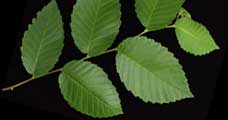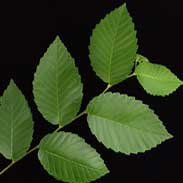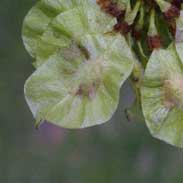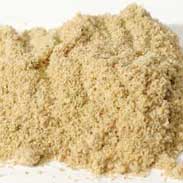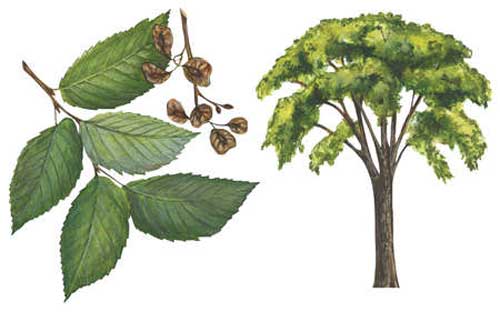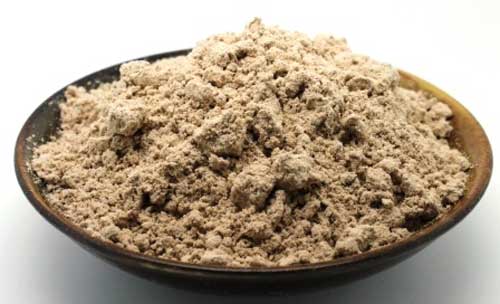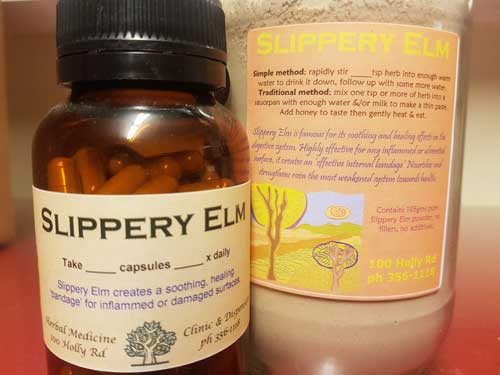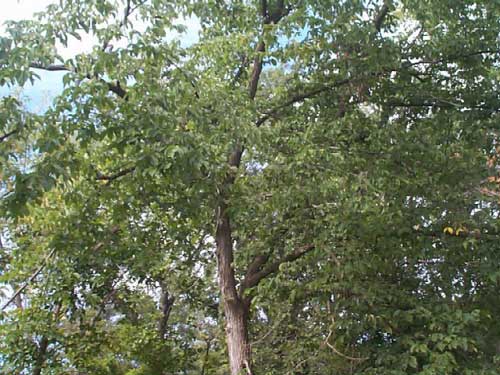
|
|
||||
| Our Pages ABOUT CONSTITUTIONAL MEDICINE
|
Slippery Elm is the name of a tree from the great Elm family that is native to North America. The part used in medicine is the powdered inner bark. Note that it is important to only use Slippery Elm bark from trees that have been sustainably harvested as this is a herb that has become increasingly endangered.
Slippery Elm has been extensively used in herbal medicine for many centuries. It has pronounced nourishing and healing properties TJ Lyle writes 'The inner bark of Slippery Elm forms one of the best demulcents for both internal and external use wherever there is an irritated condition. In constipation, dysentery, diarrhoea or cholera infantum, used both orally or by rectal injection it lubricates, soothes and relieves the intestinal irritation. It is a nutritious demulcent, soothing to the mucous membrane wherever needed and quieting to the nervous system. King's Dispensatory writes 'Slippery elm bark is a very valuable remedial agent in mucous inflammations of the lungs, bowels, stomach, bladder, or kidneys. It is also highly beneficial in diarrhoea, dysentery, coughs, pleurisy, strangury, and sore throat, in all of which it tends powerfully to allay the inflammation. A tablespoonful of the powder boiled in a pint of new milk, affords a nourishing diet for infants weaned from the breast, preventing the bowel complaints to which they are subject, and rendering them fat and healthy. Elm bark has likewise been successfully employed externally in cutaneous diseases, especially in obstinate cases of herpetic and syphilitic eruptions' The British Herbal Pharmacopoeia (BHP) describes the actions of Slippery Elm as 'demulcent, emollient, nutritive, antitussive'. It says it is indicated for 'inflammation or ulceration of stomach or duodenum. Convalescence. Colitis. Diarrhoea. Locally for boils, abscesses and ulcers as a poultice' and specifically indicated for 'gastric or duodenal ulceration'. The BHP recommends a dose of 4 grams in 500mls boiling water or the powdered bark 1:8 as a decoction. Thomas Bartram writes that the actions of Slippery Elm include 'soothing demulcent, nutrient, expectorant, antitussive. Topically as an emollient. The addition of a few grains of powder or drops of tincture of Myrrh enhances its antiseptic and healing action. Long lasting antacid barrier. Contains an abundance of mucilage'. Andrew Chevallier writes 'this marvellous herb is a gentle and effective remedy for irritated states of the mucous membranes of the chest, urinary tubules, stomach and intestines. It was used in many different ways by Native Americans; as a poultice for wounds, boils, ulcers and inflamed eyes, and internally for fevers, colds, and bowel complaints. Slippery Elm has a strongly mucilaginous 'slippery' taste and texture'
As Andrew Chevallier writes 'there is limited research into Slippery Elm, but its action as a herb with large quantities of mucilage is well understood. When the herb comes into direct contact with inflamed surfaces such as the skin or the intestinal membranes, it soothes and coats the irritated tissue, protects it from injury, and draws out toxins or irritants.
The only real safety concerns are those to be had for the tree itself! As also mentioned at the top of the page; Note that it is important to only use Slippery Elm bark from trees that have been sustainably harvested as this is a herb that has become increasingly endangered.
For some years now, against this proven and safe way of herbalism, there has been a rising tide of excessive caution and scare-mongering in many parts of the world. The same authorities that, not so long ago, decried herbal medicines as ineffectual, have now taken up a different adversarial position; that they are dangerous substances that should only be prescribed by Doctors, who of course have zero training in them. Unfortunately, the same unnecessary fear and worry has crept into many natural health websites and popular publications on herbs. Herbs that we have safely used for thousands of years, that have no reports of adverse reactions in the medical literature despite widespread use by millions of people, are suddenly described as contraindicated because of something that should have been seen as completely unimportant, or at the utmost a merely theoretical concern, such as a laboratory study on one of the herb's constituents to use an all too common example. I wonder sometimes if the writers of such articles feel that the herb will be more deserving of respect if it is thought to be a little bit dangerous, in other words more like a drug than something that has simply come out of the earth and been used by ordinary people for generations beyond count. There is just so much misinformation about herbal medicine on the internet now. Ludicrous claims and cautions abound in equal measure; it seems like one group are trying to make money out of the public whilst the other are busily trying to scare them off. I have to believe that the kind of reader who takes the time to read pages on herbs that are as extensive as this one is much less likely to be swayed by marketers or misinformers. I hope that you will keep your wits about you if you get conflicting opinions from people who have never really got to know these herbs, who have never worked with them, or learned how to use them safely and effectively. I want to remind you that the reason that herbs can never be patented and owned by any individual or corporation is because they are, and always will be, the People's medicine. They belong to all of us and it is my great hope in sharing this work that you will learn how to use them wisely for yourself, and the people you care for. Be safe, but do not be afraid.
In modern herbal practice, Slippery Elm's
two main uses are as a drawing agent when used as an external poultice and as an internal bandage for inflammation or ulceration anywhere along the digestive tract Slippery Elm in a drawing poultice is a thing to behold. It is quite remarkable how it forms a gelatinous, gooey mass that soothingly sits there but then also hoovers up foreign material or damaged tissue. Slippery Elm as an internal bandage is surely where it has provided its most dramatic healing affects and this is the method with which I have most of my own experience in using the herb. If someone has actual physical damage to a part of their digestive tract then I will often use Slippery Elm as the first choice. As much as there may well be other agents that could be beneficial that do not have the same issues of scarcity that we have with Slippery Elm I just do not know anything that can help bandage an internal wound so quickly and effectively (in our own clinic we have found a supplier that certifies the herb is harvested sustainably). You need to visualise what Slippery Elm does whilst it is in the gut to get a good feel for how to use it. Slippery Elm makes a wet, gooey, sticky mess if you dilute it and leave it to set and so, as it slowly slides down through the digestion on its way to being eliminated, it is able to make a gentle, soothing and effective bandage. As soon as a person gets a significant inflammation in their gut lining, it physically changes the surface tissues to become rough, red and sore, rather like a graze. Slippery Elm is able to stick to those sore parts, at least for a while, and so give the tissues a much-needed rest from further abrasion as material works its way through the digestive tract. However, the bandage can’t stick there forever which is why we can need to use a frequent dose of Slippery Elm, at least in the beginning, because the longer the damaged gut surfaces stay bandaged, the faster they can heal, and gut tissue can heal quickly when it is given a chance. The gut lining is just like the external skin, in that it is constantly shedding and replacing itself. It has to be like this because it is subjected to so many stresses. If you can keep that wound or graze well bandaged for long enough, which is often just a few days, then everything can quickly turn around for the good. It is recommended to use enough Slippery Elm to form a bandage and to use it as frequently and for as long as needed. In practical terms this means I may be prescribing a heaped tsp in a slurry or a gruel anywhere from one to two or sometimes even three times a day.
Capsules Slurry One very well-heaped tsp (you can get a lot of the herb on to a tsp if you try) of Slippery Elm powder equates somewhere between about 4 and 6 grams of herb and this would be equivalent to about 10-12 capsules at a time. However, not everyone will be able to take such a large dose in a powdered form, or need to take so much and, given that the soothing action of Slippery Elm should be felt rapidly, the best way to know whether capsules or powder is necessary is simply to try and see. Gruel The following is from a dear patient called Abbey, who took the above recommendation to heart and developed the following recipe. Ingredients ~ 1 small to medium apple and/or a small pear Method It can all take a bit of play and practice to get the right consistency and flavour that you desire.
Much of the information here about the traditional uses of Slippery Elm is consistent with the model of thinking whereby one may treat problem A with plant B. There is value in this approach, especially in how it helps us pass on useful knowledge to one another, but it falls short in one vital area; and that is that people are not all cut from the same cloth! Something that works brilliantly for one person may do less for another- why is this? Part of the reason is that people vary in their constitutions as to whether they are either hotter or cooler and, at the same time, either dryer or damper. This useful and rather fascinating subject is introduced further here Another big part of using the right herb when it is most needed comes from understanding the need to treat what is going wrong for the person that had led up to their getting a health condition. In this light, Slippery Elm can particularly offer its benefits when a nourishing action is needed in the 'cycle of healing', more about this here
Please understand that I cannot advise you, including on products or dosage, without seeing you in person in my clinic but for ideas
on how you might find a good herbalist in your area read here |
|
|
|
© 2011 R.J.Whelan Ltd
